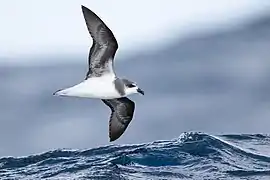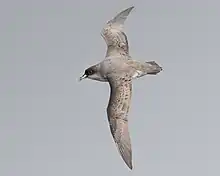List of birds of Bouvet Island
Bouvet Island is an uninhabited, sub-Antarctic island administered as a dependency of Norway. A small, isolated volcanic island at the southern tip of the Mid-Atlantic Ridge, Bouvet is located around 2,600 km (1,600 mi) southwest of South Africa and 1,600 km (990 mi) from Antarctica. The island has undergone very little human modification and, along with its surrounding waters, has been declared a protected area. Located in frigid climates south of the Antarctic Polar Frontal Zone, Bouvet experiences average annual temperatures of −2.7–1.6 °C (27.1–34.9 °F) and 93% of the island's land area is covered by permanent sheets of ice. The coastal ice-free regions consist of heaps of boulders, lava blocks and gravel, and are rapidly eroding; the largest such area, Nyrøysa, retreated 50–100 m (160–330 ft) inland from 1966 to 1979 and 6–9 m (20–30 ft) from 1996 to 1999. The island's vegetation consists of ascomycete fungi, lichens, mosses, liverworts, and algae. Vegetation is largely limited to the coasts and a few exposed mountain peaks and plateaus. Animal diversity is similarly poor: there are seven species of arthropods, one species of oligochaete worm, and two mammals (southern elephant seal and Antarctic fur seal) known from the island.
There are 40 species of birds that have been recorded from Bouvet Island. 12 of these species have confirmed breeding populations on the island, while another two, the slender-billed prion and kelp gull, are thought to breed there. The most important breeding species are the southern fulmar, with an estimated population of 100,000 breeding adults, and black-bellied storm petrel, with an estimated population of 1,000 breeding adults. A large number of penguins also breed on the island: in 1978–1979, there were an estimated 117,000 on Bouvet, mostly macaroni and chinstrap penguins. However, the penguin population declined at an annual rate of 4.8% from 1979 to 1990, falling to just 62,125 adults, and is thought to have decreased even faster subsequently. This decline is caused by changes in oceanic conditions, competition for food, and an expanding fur seal population on the island. Breeding birds on the island are threatened by the erosion of coastal breeding areas and commercial longline fishing. 19 species are summer migrants to the island. The entire protected area of Bouvet Island has been designated an Important Bird Area by BirdLife International due to its high conservation value.
This list's taxonomic treatment (designation and sequence of orders, families and species) and nomenclature (common and scientific names) follow the conventions of the 2022 edition of The Clements Checklist of Birds of the World. The family accounts at the beginning of each heading reflect this taxonomy, as do the species counts found in each family account. The following tags have been used to highlight several categories. The commonly occurring native species do not fall into any of these categories.
- (A) Accidental – A species that rarely or accidentally occurs on Bouvet Island.
Skuas and jaegers

Order: Charadriiformes Family: Stercorariidae
The family Stercorariidae are, in general, medium to large birds, typically with grey or brown plumage, often with white markings on the wings. They nest on the ground in temperate and arctic regions and are long-distance migrants.
- South polar skua, Stercorarius maccormicki
- Brown skua, Stercorarius antarctica
- Parasitic jaeger, Stercorarius parasiticus
Gulls, terns, and skimmers
Order: Charadriiformes Family: Laridae
%E2%80%93Kelp_gull_(Larus_dominicanus).jpg.webp)
Laridae is a family of medium-to-large seabirds, the gulls, terns, and skimmers. Gulls are typically grey or white, often with black markings on the head or wings. They have stout, longish bills and webbed feet. Terns are a group of generally medium to large seabirds typically with grey or white plumage, often with black markings on the head. Most terns hunt fish by diving, but some pick insects off the surface of fresh water.[1]
- Kelp gull, Larus dominicanus
- Arctic tern, Sterna paradisaea
- Antarctic tern, Sterna vittata
Penguins
Order: Sphenisciformes Family: Spheniscidae
%E2%80%93Macaroni_penguin_(Eudyptes_chrysolophus)_01.jpg.webp)
The penguins are a group of aquatic, flightless birds living almost exclusively in the Southern Hemisphere. Most penguins feed on krill, fish, squid and other forms of sealife caught while swimming underwater.
- King penguin, Aptenodytes patagonicus
- Adelie penguin, Pygoscelis adeliae
- Gentoo penguin, Pygoscelis papua
- Chinstrap penguin, Pygoscelis antarcticus
- Macaroni penguin, Eudyptes chrysolophus
Albatrosses
Order: Procellariiformes Family: Diomedeidae

The albatrosses are among the largest of flying birds, and the great albatrosses from the genus Diomedea have the largest wingspans of any extant birds.
- Yellow-nosed albatross, Thalassarche chlororhynchos
- Gray-headed albatross, Thalassarche chrysostoma
- Black-browed albatross, Thalassarche melanophris
- Sooty albatross, Phoebetria fusca
- Light-mantled albatross, Phoebetria palpebrata
- Royal albatross, Diomedea epomophora
- Wandering albatross, Diomedea exulans
Southern storm-petrels
Order: Procellariiformes Family: Oceanitidae
The southern storm-petrels are relatives of the petrels and are the smallest seabirds. They feed on planktonic crustaceans and small fish picked from the surface, typically while hovering. The flight is fluttering and sometimes bat-like.
- Wilson's storm-petrel, Oceanites oceanicus
- Black-bellied storm-petrel, Fregetta tropica
Shearwaters and petrels


Order: Procellariiformes Family: Procellariidae
The procellariids are the main group of medium-sized "true petrels", characterised by united nostrils with a medium nasal septum and a long outer functional primary flight feather.[2]
- Southern giant-petrel, Macronectes giganteus
- Northern giant-petrel, Macronectes halli
- Southern fulmar, Fulmarus glacialoides
- Antarctic petrel, Thalassoica antarctica
- Cape petrel, Daption capense
- Snow petrel, Pagodroma nivea
- Kerguelen petrel, Aphrodroma brevirostris
- Great-winged petrel, Pterodroma macroptera (A)
- Soft-plumaged petrel, Pterodroma mollis
- White-headed petrel, Pterodroma lessonii
- Blue petrel, Halobaena caerulea
- Fairy prion, Pachyptila turtur
- Broad-billed prion, Pachyptila vittata
- Antarctic prion, Pachyptila desolata
- Slender-billed prion, Pachyptila belcheri
- Gray petrel, Procellaria cinerea
- White-chinned petrel, Procellaria aequinoctialis
- Great shearwater, Ardenna gravis
- Sooty shearwater, Ardenna grisea
- Common diving-petrel, Pelecanoides urinatrix
See also
References
Specific
- Winkler, David W.; Billerman, Shawn M.; Lovette, Irby J. (2020-03-04). Billerman, Shawn M.; Keeney, Brooke K.; Rodewald, Paul G.; Schulenberg, Thomas S. (eds.). "Gulls, Terns, and Skimmers (Laridae)". Birds of the World. Cornell Lab of Ornithology. doi:10.2173/bow.larida1.01. S2CID 216448411. Retrieved 2023-06-30.
- Winkler, David W.; Billerman, Shawn M.; Lovette, Irby J. (2020-03-04). Billerman, Shawn M.; Keeney, Brooke K.; Rodewald, Paul G.; Schulenberg, Thomas S. (eds.). "Shearwaters and Petrels (Procellariidae)". Birds of the World. Cornell Lab of Ornithology. doi:10.2173/bow.procel3.01. S2CID 216494761. Retrieved 2023-06-30.
General
- Lepage, Denis. "Checklist of Birds of Bouvet Island". Bird Checklists of the World. Avibase. Retrieved 2023-06-29.
- Clements, James F.; Schulenberg, Thomas S.; Illif, Marshall J.; Fredericks, T. A.; Gerbracht, J. A.; Lepage, Daniel; Billerman, Shawn M.; Sullivan, Brian L.; Wood, Christopher L. (2022). The eBird/Clements Checklist of Birds of the World: v2022. 16 (6 ed.). Cornell University Press.
- Huyser, Onno (2001). "BOUVETØYA (Bouvet Island)" (PDF). In Fishpool, L. D. C.; Evans, M. I. (eds.). Important Bird Areas in Africa and Associated Islands: Priority Sites for Conservation. Cambridge: Pisces Publications. pp. 113–115.
.svg.png.webp)
